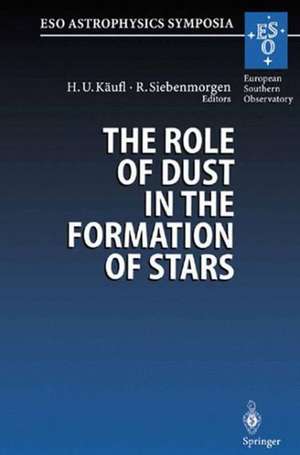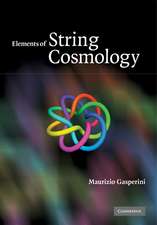The Role of Dust in the Formation of Stars: Proceedings of the ESO Workshop Held at Garching, Germany, 11–14 September 1995: ESO Astrophysics Symposia
Editat de Hans U. Käufl, Ralf Siebenmorgenen Limba Engleză Paperback – 3 oct 2013
Din seria ESO Astrophysics Symposia
- 15%
 Preț: 656.43 lei
Preț: 656.43 lei - 15%
 Preț: 656.10 lei
Preț: 656.10 lei -
 Preț: 369.78 lei
Preț: 369.78 lei -
 Preț: 404.51 lei
Preț: 404.51 lei - 15%
 Preț: 644.95 lei
Preț: 644.95 lei - 15%
 Preț: 656.43 lei
Preț: 656.43 lei -
 Preț: 391.97 lei
Preț: 391.97 lei - 18%
 Preț: 971.01 lei
Preț: 971.01 lei -
 Preț: 434.94 lei
Preț: 434.94 lei - 15%
 Preț: 650.86 lei
Preț: 650.86 lei -
 Preț: 402.98 lei
Preț: 402.98 lei -
 Preț: 403.90 lei
Preț: 403.90 lei -
 Preț: 412.78 lei
Preț: 412.78 lei - 15%
 Preț: 645.47 lei
Preț: 645.47 lei -
 Preț: 431.30 lei
Preț: 431.30 lei - 15%
 Preț: 649.06 lei
Preț: 649.06 lei -
 Preț: 402.56 lei
Preț: 402.56 lei - 15%
 Preț: 647.27 lei
Preț: 647.27 lei -
 Preț: 413.15 lei
Preț: 413.15 lei -
 Preț: 409.30 lei
Preț: 409.30 lei -
 Preț: 430.10 lei
Preț: 430.10 lei -
 Preț: 406.42 lei
Preț: 406.42 lei - 15%
 Preț: 658.05 lei
Preț: 658.05 lei - 20%
 Preț: 590.38 lei
Preț: 590.38 lei -
 Preț: 400.65 lei
Preț: 400.65 lei -
 Preț: 413.15 lei
Preț: 413.15 lei - 15%
 Preț: 658.70 lei
Preț: 658.70 lei -
 Preț: 401.79 lei
Preț: 401.79 lei -
 Preț: 436.70 lei
Preț: 436.70 lei -
 Preț: 404.13 lei
Preț: 404.13 lei
Preț: 399.12 lei
Nou
Puncte Express: 599
Preț estimativ în valută:
76.40€ • 83.01$ • 64.21£
76.40€ • 83.01$ • 64.21£
Carte tipărită la comandă
Livrare economică 21 aprilie-05 mai
Preluare comenzi: 021 569.72.76
Specificații
ISBN-13: 9783662225158
ISBN-10: 3662225158
Pagini: 488
Ilustrații: XXII, 461 p.
Dimensiuni: 155 x 235 x 26 mm
Greutate: 0.68 kg
Ediția:Softcover reprint of the original 1st ed. 1996
Editura: Springer Berlin, Heidelberg
Colecția Springer
Seria ESO Astrophysics Symposia
Locul publicării:Berlin, Heidelberg, Germany
ISBN-10: 3662225158
Pagini: 488
Ilustrații: XXII, 461 p.
Dimensiuni: 155 x 235 x 26 mm
Greutate: 0.68 kg
Ediția:Softcover reprint of the original 1st ed. 1996
Editura: Springer Berlin, Heidelberg
Colecția Springer
Seria ESO Astrophysics Symposia
Locul publicării:Berlin, Heidelberg, Germany
Public țintă
ResearchCuprins
Contents: Ground-Based Observations of Young Stellar Objects.- Observations of Dust Factories.- Observational Results Based on IRAS, COBE or Ballon Borne Platforms.- Vega-type, T-Tauri, *Bootis and Herbig Ae/Be Stars.- Properties of Dust around Young Stellar Objects.- Ices and Laboratory Studies.- Radiative Transfer.- Dust as a Catalytic Agent for Star Formation.- Miscellaneous.- Concluding Remarks.
Textul de pe ultima copertă
This book, which is published in the early phase of ESA s Infrared Space Observatory mission, provides a comprehensive summary of the knowledge in this field of astronomy. In a series of invited review lectures and numerous contributed papers the role of dust in the formation of stars is described and discussed.
Dust is ubiquitous in star-forming regions, protostars, young stellar objects and stars in various pre-main-sequence stages up to perfectly normal main-sequence stars. Consequently the authors address the topic from rather different viewpoints. Observers describe and analyze signatures of dust in the entire electromagnetic spectrum from the radio to the ultra-violet. Successfull modelling of these signatures with radiative transfer codes is demonstrated for a great variety of sources. Astrophysical laboratory researchers report on studies of synthetic prototype samples of interstellar dust. Other topics covered in this book are dust processing, dust agglomeration, dust coupling to the magnetic field or dust electric charging. Moreover, the reader will learn about dust chemical composition, gas-phase chemistry and photo-chemistry. From a mostly theoretical viewpoint the role of dust as a catalytic agent for star formation is described in great detail.
Dust is ubiquitous in star-forming regions, protostars, young stellar objects and stars in various pre-main-sequence stages up to perfectly normal main-sequence stars. Consequently the authors address the topic from rather different viewpoints. Observers describe and analyze signatures of dust in the entire electromagnetic spectrum from the radio to the ultra-violet. Successfull modelling of these signatures with radiative transfer codes is demonstrated for a great variety of sources. Astrophysical laboratory researchers report on studies of synthetic prototype samples of interstellar dust. Other topics covered in this book are dust processing, dust agglomeration, dust coupling to the magnetic field or dust electric charging. Moreover, the reader will learn about dust chemical composition, gas-phase chemistry and photo-chemistry. From a mostly theoretical viewpoint the role of dust as a catalytic agent for star formation is described in great detail.














